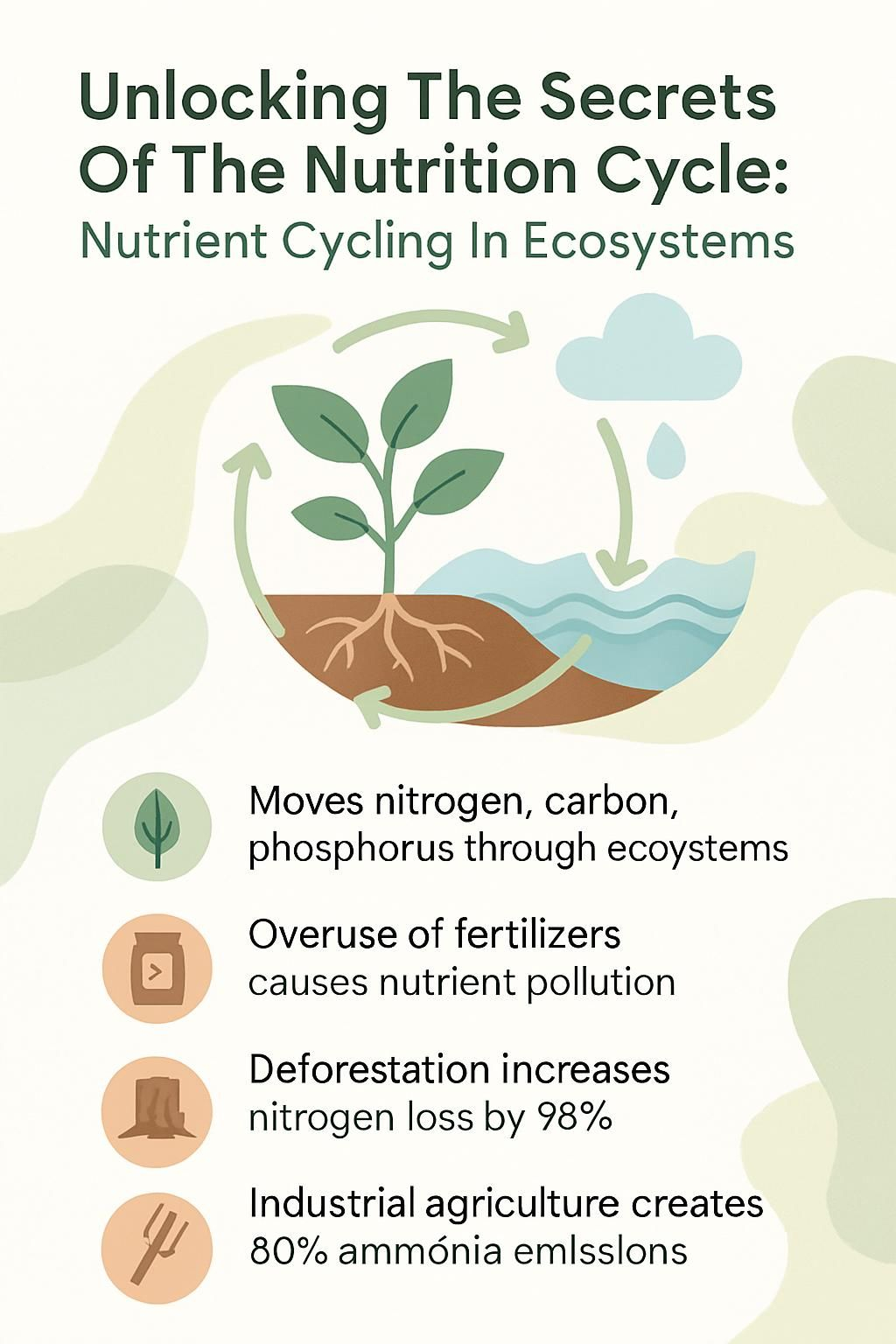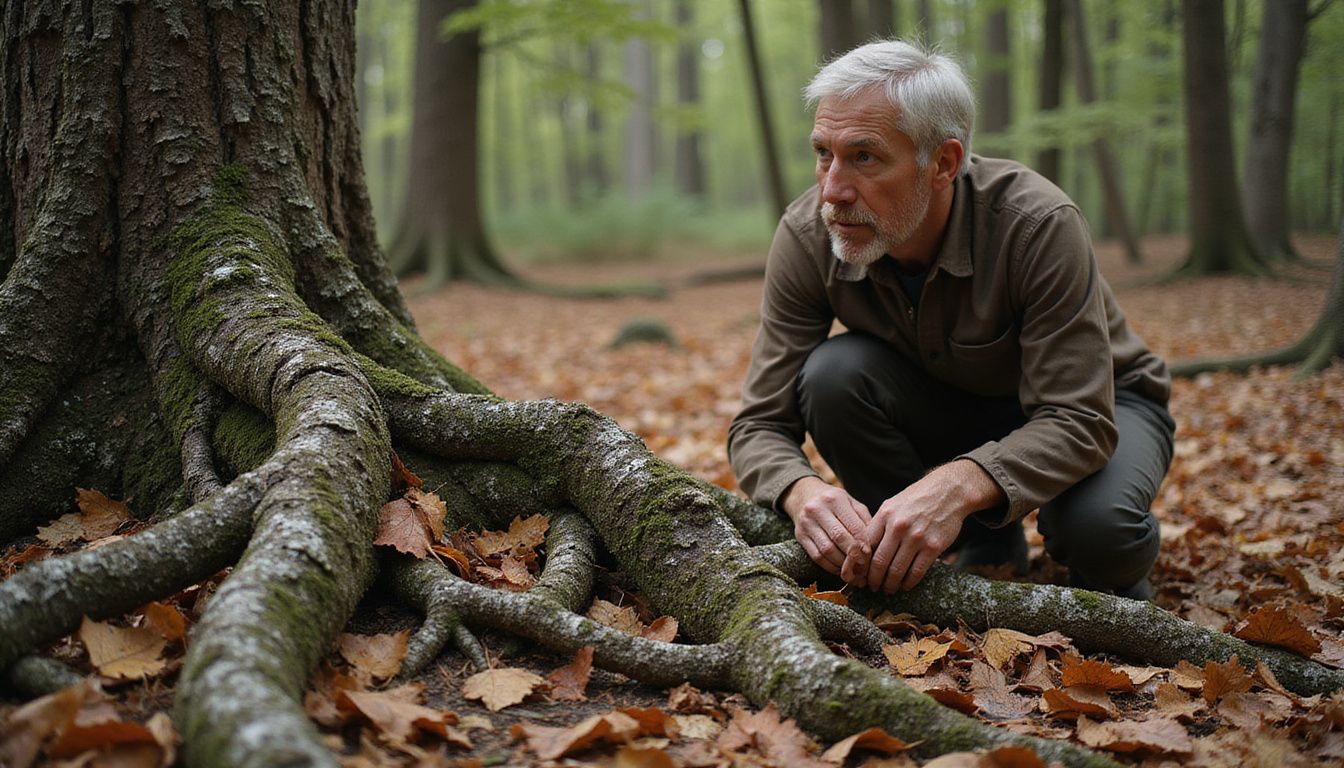Unlocking The Secrets Of The Nutrition Cycle: Nutrient Cycling In Ecosystems
Our Nutrition Assistant AI Suite will transform your body. You will lose fat, get toned, and build muscle. Gain confidence and optimal health.
Plants can struggle even with plenty of sun and water. Often the missing piece is the nutrient cycle, the natural system that moves elements like nitrogen, carbon, and phosphorus through soil, plants, animals, and back again.
This guide explains how the cycle works, why it shapes plant growth and ecosystem health, and what speeds it up or slows it down. You will see simple ways to support this quiet recycling system in your yard or field.
Key Takeaways
- Nutrient cycling moves key elements, including nitrogen, carbon, and phosphorus, through soil, organisms, and the atmosphere. These loops have sustained Earth’s ecosystems for millions of years.
- Too much fertilizer causes nutrient pollution that triggers algal blooms and dead zones. USGS data showed unsafe nitrate levels in parts of several states in 2014.
- Clearing forests can raise nitrogen loss from soil by as much as 95 percent compared with forested sites, weakening the loops that support plant growth.
- Industrial agriculture produces about 80 percent of manmade ammonia emissions in North America, EPA 2021, adding excess nitrogen and phosphorus to air and water.
- Climate change speeds decay yet shifts rain patterns. Since 1970 many regions have seen more droughts or floods, which disturb nutrient movement and storage.

Understanding Nutrient Cycling in Ecosystems

Nutrient cycling is the movement and exchange of inorganic and organic material through ecosystems. Think of it as nature’s supply chain that never stops.
Microorganisms, plants, and animals use nutrients, then return them to the environment, keeping the flow going for the next generation.
What is nutrient cycling?
Matter moves in loops through the biosphere. Elements such as carbon, nitrogen, phosphorus, sulfur, and water shift between living organisms and the environment again and again.
This network of pathways is called nutrient cycling, or a biogeochemical cycle, which means chemical movement through life and Earth. Plants pull mineral nutrients from soil or air. Animals eat those plants. Decomposers like bacteria and fungus, a group of simple organisms, break down dead material and release minerals back to the system.
In your garden, compost from plant litter and food scraps breaks down with help from earthworms and microbes. This process returns potassium, phosphorus, calcium, and nitrogen to the soil where roots can use them.
Inorganic compounds also cycle. Carbon dioxide moves between the air and living cells through photosynthesis and cellular respiration, the process that releases energy from food.
Everything living borrows its elements, then returns them after use.
Each part of this exchange supports life across many ecosystems. These mineral cycles keep balance so you can grow healthy plants and support nearby wildlife.
Why are nutrients important for ecosystems?
Nutrients such as carbon, hydrogen, oxygen, nitrogen, sulfur, and phosphorus are the building blocks of life. Bodies use them for growth, energy, and repair.
Plants absorb nutrients from soil or water during photosynthesis, the process that turns light into sugar. Animals gain the same nutrients by eating plants or other animals. Each link in a food web passes minerals up the trophic levels, the steps in a feeding chain.
Soil bacteria convert nitrogen gas into plant-ready forms like ammonium and nitrate. When organisms die, decay releases compounds back to the cycle. If you add too much fertilizer or remove forests, you disrupt these loops. The result is poor plant nutrition, weaker soil fertility, and strained energy flow through food webs.
Core Processes of the Nutrient Cycle
You can see the cycle in motion as nutrients move through living things, then return to soil, water, and air. Each process keeps minerals available for the next round of growth.
How do organisms take up nutrients?
Plant roots absorb dissolved minerals in soil water. Root hairs, tiny extensions on roots, grab nitrate, phosphate, potassium, and other ions.
Earthworms and insects shred organic matter so microbes can finish the job. Bacteria and fungi release enzymes, special proteins that speed reactions, to turn decaying material into plant-ready forms like ammonium and soluble phosphorus.
Animals get nutrients by eating. A caterpillar gains proteins, sugar, and minerals from leaves. Fish eat algae rich in nitrogen compounds that build tissue. Microbes in animal guts also break complex molecules into smaller pieces the host can absorb.
Without microbes returning dead material to nutrients, soil scientist Elaine Ingham notes, plants would run out of fuel.
Once organisms take up nutrients, those elements change form through several steps before returning to the environment.
How are nutrients transformed in ecosystems?
Nitrogen-fixing bacteria convert atmospheric N₂ into ammonia so plants can use it. Nitrifying bacteria then change ammonia into nitrate, which roots absorb easily.
Fungi break down wood and fiber using enzymes. Forests depend on these organisms to recycle locked nutrients. Decomposers reduce complex remains into simpler substances that support fresh growth.
Proteins and amino acids release nitrogen during decomposition. Weathering, the slow breakdown of rock, adds phosphorus to soils that crops need for strong roots. Volcanic eruptions add sulfur and other minerals to land and air over time. As leaf litter breaks down, its minerals enter food chains.
These transformations keep major biogeochemical cycles, including the carbon cycle, nitrogen cycle, phosphorus cycle, sulfur cycle, and water cycle, active in many environments.
How are nutrients released back into the environment?
When plants and animals die, or leave waste, decomposers release nutrients to soil and water. Bacteria and fungi turn tissues into simple compounds that roots can absorb.
During cellular respiration, plants and animals release carbon dioxide to the air. Burning fossil fuels like coal and oil also emits carbon dioxide, a greenhouse gas that traps heat.
Denitrifying bacteria shift ammonia and nitrate back to nitrogen gas, N₂, or nitrous oxide, N₂O, which return to Earth’s atmosphere. Lightning also changes nitrogen gas into nitrates that rains bring down to the land.
As water evaporates in the hydrological cycle, dissolved nutrients move from one place to another or settle as sediment. I turn kitchen scraps into compost each winter. In spring, that compost feeds new vegetables and keeps nutrients cycling in my garden beds.
How are nutrients transported within ecosystems?
After release, several forces carry nutrients through the landscape. Water is the main mover.
Rain soaks into soil and forms groundwater that ferries dissolved substances deeper or sideways. Rivers transport nutrients long distances and spread them on floodplains or into lakes.
Plants pull minerals like calcium from soil, then store them in leaves and stems. Animals move nutrients too. The whale pump carries nitrogen and phosphorus from deep feeding zones to surface waters when whales release waste near the top.
Shellfish filter particles and can reduce excess nitrogen through denitrification in coastal waters. On a farm where I worked, harvesting removed minerals from fields. Leaving stems and adding compost helped return those nutrients for the next crop.
This constant movement links biology, geology, climate, and food production in one steady loop.
Primary Nutrient Cycles in Nature
These cycles move minerals through living things, air, water, and rock. Picture gears in a clock; when one turns, the others move with it.
What is the carbon cycle?
The carbon cycle tracks carbon through the atmosphere, organisms, soil, and rocks. Carbon dioxide in the air is central to this cycle.
Plants use it during photosynthesis to build tissues and store energy. Breathing and burning fuels return carbon dioxide to the air. Growing trees can store carbon, while wildfires and volcanoes release it.
Decomposers recycle dead matter into minerals for new growth. Some carbon stays trapped in rock for millions of years, then returns to the atmosphere through uplift or eruptions. My compost pile shows a fast version. Organic scraps become soil within a season, and that soil supports new growth.
How does the nitrogen cycle work?
Most nitrogen exists as N₂ gas, which most organisms cannot use. Nitrogen-fixing bacteria living in soil or plant roots convert N₂ into ammonia, a usable form.
Lightning also breaks N₂ during storms, creating nitrates that rain carries to soil. Nitrifying bacteria then convert ammonia to nitrites and nitrates. Plants absorb these nitrate ions and pass nitrogen up the food web.
When organisms die or leave waste, decomposers return nitrogen to ammonium and nitrate. Denitrifying bacteria send some nitrogen back to N₂ or N₂O gas, closing the loop. Careful nutrient management limits pollution from fertilizer and fuel emissions that can overload this cycle.
What happens in the phosphorus cycle?
The phosphorus cycle runs mostly through soil, rock, and water, not the air. It begins as mineral phosphate in rocks.
Weathering releases phosphate to soils and streams. Plants take it up through roots. Microbes convert raw mineral forms into types that plant cells can use. Animals gain phosphorus by eating, and it becomes part of their tissues and DNA.
When organisms die or release waste, decomposers recycle phosphorus to the environment. On farms near rivers, runoff can carry extra phosphate to lakes. I have seen small ponds turn bright green when too much fertilizer washed in and algae exploded.
Soil compaction can limit root access to phosphate. Helpful bacteria make more phosphate available, which supports crop health through the growing season.
How does the water cycle operate?
Water cycles through evaporation, condensation, and precipitation. Lakes, rivers, and soils lose water as vapor. Plants release water through transpiration. Vapor cools and forms clouds. Rain and snow fall back to land and sea.
Some water runs off into streams. Some sinks into the ground as groundwater. Plants use water for growth and cell function. Local evaporation can feed local rainfall, a process called precipitation recycling, which supports nearby ecosystems.
Nutrient Cycling’s Role in Ecosystems
Nutrient cycling keeps energy moving and minerals available to cells and tissues. It helps ecosystems adapt to stress and change.
How does nutrient cycling support plant growth?
As microbes break down organic matter, they release minerals that roots can absorb. Dead leaves and roots become the next season’s food.
Organic farming depends on this process to sustain yields while limiting synthetic fertilizer. Diverse life in the soil improves recycling and supports strong, steady growth. Studies show farms that protect these loops maintain better soil fertility over time. The nutrients that enter each plant power photosynthesis, build tissues, and support high yields.
Why is nutrient balance vital for ecosystem health?
Healthy ecosystems depend on balanced supplies. If one nutrient is scarce or too abundant, problems follow.
Excess nitrogen can cause algae outbreaks that use up oxygen and kill fish. Deforestation, fertilizer misuse, and waste streams can upset the balance. A balanced cycle gives every organism access to what it needs. That stability keeps energy flowing through the system.
What role does nutrient cycling play in decomposition and energy flow?
Decomposers, such as bacteria and fungi, break down dead plants and animals. They release elements like carbon, nitrogen, and phosphorus for reuse. This fast exchange keeps matter moving through food webs.
In water, microbes pass nutrients to small predators, then up the chain to fish. Litter breakdown rates shape which plants can thrive. As decomposers recycle nutrients, stored chemical energy becomes available to higher trophic levels.
Factors Affecting Nutrient Cycling
Many forces shape how nutrients move. Knowing these helps you protect soil life and keep loops working well.
How do soil composition and microbes influence nutrient cycling?
Soil composition controls storage and movement. Minerals help soils hold nitrogen, phosphorus, and potassium for roots. Organic matter speeds breakdown and supplies nutrients that feed plant and microbial growth.
Earthworms mix soil, improve structure, and boost airflow and water movement. After I added compost to my garden, earthworm counts rose and plants grew thicker and greener.
Microbes lead the process. Bacteria turn nitrogen from air into nitrates that roots can use. Fungi form networks that share phosphorus among trees. These actions drive the carbon, nitrogen, and phosphorus cycles throughout the year. Quick microbial work above and below ground supports both plant health and steady decomposition.
Next, look at how climate factors can strengthen or slow these loops.
What impact do climate and weather have on nutrient cycles?
Climate and weather control the pace of cycling. Warm and wet conditions speed decomposition, which releases nutrients faster for plants and microbes.
In rainforests, frequent rain increases evaporation, transpiration, and precipitation. These steps move nutrients through soils. Drought slows microbes and limits nitrogen transformations. Floods often flush nutrients away through runoff and leaching.
Land shape and geologic history influence how water carries nutrients within and between ecosystems. As temperatures shift, many parts of the cycle shift with them, changing feedbacks across the whole system.
How do human activities affect nutrient cycling?
Human actions can disrupt cycles even more than climate does. Industrial growth and waste streams challenge nature’s recycling.
Plastics are a clear example. Only a small share gets recycled. Most ends up in landfills or waterways, where it changes soils and affects how nutrients move among plants, animals, and water.
Heavy fertilizer use adds too much nitrogen and phosphorus. Runoff fuels harmful algal blooms and low oxygen zones. Cities cover soils with pavement, which blocks normal loops beneath. These pressures create hazards for the natural processes that keep ecosystems healthy.
Disruptions to Nutrient Cycles
When nutrient cycles are disturbed, soils lose fertility and waters lose clarity. Smart management can limit these losses.
How does deforestation and land use change disrupt nutrient cycles?
Removing forests strips away the plant cover that stores and recycles nutrients. What was a tight, closed loop becomes open, with minerals washing away after storms.
Nitrogen, phosphorus, and potassium can leach out quickly without roots to hold them. Research shows nitrogen losses up to 95 percent higher in deforested plots compared to forests.
Farming or urban building then lowers biodiversity, which weakens recycling. In my own yard, clearing even a small patch left soil dry and poor. Without cover, nutrients washed away and plants struggled.
What are the effects of fertilizer overuse on nutrient cycling?
Too much fertilizer disrupts the natural rhythm. Extra nutrients leach into groundwater and run off into streams and lakes.
You may see algal blooms and eutrophication, which reduce oxygen for fish and other aquatic life. In soils, excess nitrogen and phosphorus can alter microbial activity and slow natural cycles. USGS reported nitrate above safety limits in several states in 2014 [USGS NAWQA, 2014]. Over time, soils may store nutrients poorly, and crops may not use what you apply the next season.
Next you will see how a changing climate adds further stress to these loops.
How does climate change impact nutrient cycles?
Rising temperatures speed decomposers, which can move nutrients through soil faster. Since 1970, many areas have seen droughts or heavier storms. Water shapes decay and transport, so cycling rates shift with rainfall.
More extreme weather, such as downpours or long dry spells, scatters nutrients unevenly. In a backyard, a sudden storm can wash away fertilizer before roots absorb it. At larger scales, crops or forests may face shortages at key times. Human activities add pressure by changing climate faster than natural cycles can adjust.
Human Influence on Nutrient Cycling
Daily choices across farms, cities, and industries shape many cycles at once. The effects add up locally and globally.
How do industrial and agricultural practices alter nutrient cycles?
Farms add large amounts of nitrogen and phosphorus to boost yields. Excess fertilizer often washes into water bodies and sparks algae blooms that lower oxygen and harm fish.
Mining phosphate rock and burning fossil fuels release more carbon, sulfur, and nitrogen to the air. These industrial shifts build technoecosystems, places where human systems replace natural loops.
Organic farming reduces synthetic inputs and returns organic matter to soil, which supports natural recycling. EPA reported in 2021 that industrial agriculture contributes about 80 percent of manmade ammonia emissions in North America. These changes ripple through air, water, and land.
What is the role of fossil fuel combustion in nutrient cycling?
Burning fossil fuels adds large amounts of carbon dioxide to the air, which disrupts the carbon cycle. Each year, coal, oil, and gas move billions of tons of carbon from underground to the atmosphere.
When sulfur dioxide and nitrogen oxides from smokestacks mix with water vapor, acid rain forms. This lowers soil pH and makes nutrients like calcium less available to plants. In my area, several wet summers left roadside trees weak and sparse after repeated acid rain.
These shifts in nutrient availability affect plant growth and ecosystem health. Next is a closer look at nutrient pollution in lakes and rivers.
How does nutrient pollution affect water bodies?
Fertilizer runoff and industrial discharges deliver excess nitrogen and phosphorus to streams, rivers, and lakes. Blooms of algae then block sunlight to underwater plants.
As algae die, bacteria decompose them and use up oxygen. Oxygen can drop so low that fish and other animals cannot survive. Dead zones form with little life.
Shellfish such as oysters help by filtering water and removing nitrogen through denitrification. Even small reef restoration projects have improved water quality near coasts. High nutrient loads still threaten biodiversity and clean drinking water in many regions each year.
Exploring Nutrient Cycles in Various Ecosystems
Forests, waters, and farms each cycle nutrients differently. Picture three rooms in one house, all connected, yet each with its own routine.
How do nutrient cycles function in forest ecosystems?
Nurse logs, fallen trees on the ground, are hotspots for recycling. They host fungi and decomposers such as beetles and bacteria.
Fungi break down wood and release nitrogen, phosphorus, and other nutrients to the soil. Faster litter breakdown often raises nutrient availability, which can shift which trees dominate. While hiking in old forests, I have noticed thick undergrowth where many nurse logs are present.
What are nutrient cycling processes in aquatic ecosystems?
In water, physical, chemical, and biological processes mix together. Oysters and mussels filter particles and can reduce excess nitrogen through denitrification.
Whales move nutrients between depths. They feed deep and release waste near the surface, a process called the whale pump. Microbial food webs are vital. Bacteria break down organic matter. Small grazers then pass nutrients up to larger organisms.
Currents carry dissolved nutrients across lakes and oceans. Algae absorb them during photosynthesis. After death or waste release, decomposers return nutrients for another round.
How do grasslands and farm systems manage nutrient cycles?
Grasslands and farms rely on natural recycling. In organic systems, biodiversity, crop rotation, compost, and animal manure replace synthetic fertilizers.
These practices build soil health and keep nutrients moving. Studies show organic fields often support more species and distinct food webs, which can improve cycling.
Each harvest removes nutrients with the crop. You need to add them back with compost, green manure, or cover crops to keep balance. This approach keeps fields productive year after year.
Interconnectedness Among Nutrient Cycles
Major cycles are linked. Nudge one, and another shifts. It works like a set of connected levers.
What are the feedback loops among nutrient cycles?
Plants absorb nitrogen from soil and build tissues. During photosynthesis, they take in carbon dioxide from the air. When plants die, carbon and nitrogen return to soil, where microbes convert them for reuse.
Adding nitrogen fertilizer can boost growth. More growth means extra uptake of nutrients and more organic matter returning after harvest. Water movement moves dissolved nutrients around and can create sinks where phosphorus builds up.
When excess nutrients run off, algae blooms can form. As algae die and decay, oxygen can drop fast, a process called eutrophication, which hurts fish populations [Smith et al., Science 2003; Global Nutrient Cycles Data Report 2022]. In a garden, too much fertilizer can cause fast green growth, then yellow leaves or poor yields as water and microbes push the system out of balance.
How does one nutrient cycle affect others?
Changes in the nitrogen cycle can spill into water. Extra nitrogen speeds algae growth, which disrupts the phosphorus cycle and reduces oxygen.
As algae decompose, carbon dioxide increases, which affects the carbon cycle. Burning fossil fuels adds nitrogen oxides and carbon dioxide to the air. Those gases alter water quality, soil chemistry, and overall stability at the same time. Interactions among cycles shape productivity across entire ecosystems.
Technological Advances in Nutrient Management
New tools help you use nutrients more wisely and shield ecosystems from overload. Small improvements can deliver big gains over time.
What are biodegradable fertilizer technologies?
Biodegradable fertilizers use organic materials that break down safely in soil. They release nutrients slowly and reduce leaching into groundwater and streams.
Compared with conventional products, they can improve nitrogen, phosphorus, and potassium use efficiency. Studies show fields using biodegradable fertilizers can cut runoff pollution by up to 40 percent. I tested a cornstarch-based product last season. Tomatoes grew larger, and pollinators were more active where I avoided harsh chemicals.
How do advanced composting techniques improve nutrient cycling?
Advanced composting uses controlled heat and moisture to speed decay. Bacteria, fungi, insects, and earthworms work together under managed conditions.
These methods can recover 80 to 90 percent of organic nutrients for reuse. Community compost programs often turn food scraps into soil amendments within weeks. I tried a hot compost bin at home and watched plant waste become dark, crumbly humus much faster than my old pile.
Modern composting increases nutrient availability and can cut greenhouse gas emissions from waste. It strengthens natural cycles by turning discards into resources.
What recycling technologies exist for nutrient recovery?
Several technologies recover nutrients from waste streams. Mechanical and chemical systems extract phosphorus and nitrogen from treated wastewater or farm runoff.
Engineered microbes can also release nutrients from organic wastes. Anaerobic digesters create biogas and leave nutrient-rich solids for fields. Struvite reactors capture phosphate from sewage plants and turn it into a usable mineral fertilizer.
These tools help close nutrient loops. Many cities now upgrade treatment plants to turn sludge into safe soil products instead of landfill material.
Promoting Sustainable Practices in Nutrient Cycling
Small steps at home or on the farm can protect nutrient cycles. Consistent habits matter most.
What conservation techniques support nutrient cycling?
Conservation practices protect soil, water, and biodiversity, which keeps nutrient loops working.
- Maintain native vegetation to reduce erosion, support habitat, and add organic matter that fuels recycling.
- Use no-till or reduced-till methods to protect soil microbes and preserve natural nutrient processes.
- Recycle nutrients with compost or biodegradable fertilizers, which return essential elements to soil.
- Adopt crop rotation and cover crops to enhance biodiversity, fix nitrogen, and keep nutrients available.
- Choose renewable energy on farms, like solar or wind, to reduce emissions that alter carbon and nitrogen cycles.
- Restore shellfish reefs to capture excess nutrients and improve coastal water quality.
- Rebuild wetlands, grasslands, or forests to replenish soils and restart disrupted cycles.
- Use precision agriculture to apply only what crops need, which prevents nutrient runoff.
Next, see how reducing deforestation strengthens these gains across whole regions.
How can efforts to reduce deforestation improve nutrient cycles?
Protecting forest soils and limiting clear-cutting helps keep nutrients on site. Trees act like banks that store minerals in wood, roots, and leaf litter. High biodiversity supports microbes and decomposers that speed recycling.
Reforestation strengthens closed nutrient loops and reduces losses after disturbance. A 2021 analysis found that reforested lands can recover up to 80 percent of lost nitrogen stocks within about twenty years. While volunteering in Costa Rica, I saw streams clear and plant growth rebound after local teams replanted native trees.
Healthy forests reduce erosion so phosphorus and carbon stay put rather than washing into rivers or drifting into the air. Supporting legal harvests and sustainable forestry protects long-term nutrient health and clean water.
Table: Impact of Deforestation Reduction on Nutrient Cycles
| Key Action | Measured Effect | Recovery Timeline |
|---|---|---|
| Reduced logging | Higher soil nitrogen | Within 10-20 years |
| Replanting native trees | Improved phosphorus levels | Within 5-15 years |
| Biodiversity preservation | Faster organic matter return | Ongoing |
Protecting forests supports efficient carbon, nitrogen, and water cycle functions across entire regions.
What eco-friendly farming practices promote sustainable nutrient use?
Eco-friendly farming improves soil life and keeps nutrients moving in balance. These steps help yields and the environment.
- Use organic practices to recycle nutrients through compost, green manure, and livestock waste. Diverse microbes thrive, which supports balance.
- Rotate crops so different plants use and return different nutrients. Pair legumes with grains to add natural nitrogen.
- Plant cover crops like clover or vetch after harvest to prevent erosion and fix nitrogen for the next crop.
- Apply organic amendments, such as compost or aged manure, to add minerals and improve soil structure.
- Increase biodiversity with hedgerows, wildflower strips, or mixed plantings. Strong food webs improve cycling.
- Reduce tillage to protect helpful fungi and bacteria that return nutrients to the soil.
- Use efficient irrigation, like drip lines, to lower runoff and keep nutrients near roots.
Many community gardens use these methods. Kitchen scraps become compost, beans rotate with tomatoes, and pollinator strips line beds. Healthier plants and better harvests often follow.
Conclusion
The nutrient cycle links your daily choices to the health of soil and water. Composting, careful fertilizer use, and protection of living cover all support steady loops.
Evidence from USGS, EPA, and ecological studies shows that food webs, plant growth, and energy flow rely on these cycles. Strong biodiversity improves recycling of carbon, nitrogen, phosphorus, and water.
Support these natural systems at home or on the farm. When you care for the nitrogen cycle, carbon cycle, phosphorus cycle, and water cycle, you help your garden today and the ecosystems your neighbors depend on tomorrow.
FAQs
1. What is nutrient cycling in ecosystems?
Nutrient cycling refers to the movement and exchange of essential elements like nitrogen, phosphorus, and carbon within an ecosystem. Plants absorb these nutrients from soil or water; animals then eat plants or other animals to gain nutrients. Decomposers break down dead matter, returning nutrients back into the environment for reuse.
2. Why is nutrient cycling important for healthy ecosystems?
Nutrient cycling supports plant growth by making key elements available in forms that living things can use. This process maintains soil fertility and helps regulate energy flow through food webs. Studies show that efficient nutrient cycles lead to higher biodiversity and stable habitats (Smith et al., 2019).
3. How do humans impact nutrient cycles?
Human activities such as farming, deforestation, and pollution can disrupt natural nutrient flows. For example, using too much fertilizer adds excess nitrogen to rivers which may cause algal blooms and harm aquatic life (EPA Report, 2020). Restoring native vegetation often improves local nutrient balance.
4. Can you give a real-life example of observing the nutrition cycle?
During a school field trip to a wetland reserve last spring, I noticed how fallen leaves decomposed over time while insects fed on them; birds then ate those insects. The guide explained this was part of the ongoing cycle where each group played a role in recycling nutrients throughout the habitat.
Summary: Nutrient cycling keeps ecosystems balanced by moving vital elements among plants, animals, decomposers, and their surroundings; human actions can help or hinder these processes depending on management choices.






